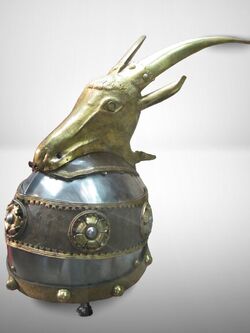| Skanderbeg's Helmet | |
|---|---|

| |
|
Origin |
Skanderbeg |
|
Type |
Helmet |
|
Effects |
Unites people of various backgrounds with a mental network |
|
Downsides |
Transmits emotions not direct communications |
|
Activation |
Wearing |
|
Collected by |
Warehouse 10 |
|
Section |
|
|
Aisle |
206834-5598 |
|
Shelf |
154599-2365-008 |
|
Date of Collection |
August 1744 |
| [Source] | |
Origins[]
Skanderbeg (1405 – 17 January 1468) was an Albanian nobleman who led a rebellion against the Ottoman Empire for 25 years in the area of modern Greece-Italy-Albania. After 20 years of education and service, he was appointed sanjakbey (governor) of Dibra in 1440. He deserted the army in favor of helping the Christians in the empire in 1443. The next year, local leaders declared him commander of their forces. Most of his support came from people of different ethnicities, not the Ottoman or Venetian controlled areas. Slavs, Wallachians, Greeks and Neapolitan mercenaries all unified around his rebellion. However, many Albanian royal families were pitted against another and experienced more of a civil war between them.
Most victories were concentrated in a small area of northern Albania, but they were able to resist the superior numbers of the Ottoman forces. He legally recognized Naples as an independent kingdom, gaining an ally after helping fend the throne of succession. Pope Pius II was in the midst of gathering crusaders for Skanderbeg, but he died early so the Venetians assisted instead in Skanderbeg's last battles. Along with campaigns by Vlad the Impaler and Stephen III the Great of Moldavia, the Ottomans were unable to reach western Europe beyond the Balkans. He is now considered a national hero and founder of Albania.
Effects[]
Creates a low-fidelity psychic network between people within the same loose coalition. Useful for sending vestiges of a plan across unrelated individuals to get them working in tandem across geography, language or culture for a larger goal. Only activates when the wearer has a commander level of experience of difficult life situations that make them suitable for organizing everyone and making any tough decisions. On the magnitude of thousands is where connection between people declines rapidly until it eventually ends and deactivates itself from sheer numbers alone.
Soldiers within one military unit don't notice any shared effects between another because they already have worked on their implicit, shared mindset during training. But soldiers between different regiments in the same army or even allied ground forces have a heightened connection. More similarities and greater goal alignment between complete strangers strengthens the bonds. They at first can feel the emotional state of their most trusted comrades, then more people get wrapped in with time. Although unable to beam information like computer data, they can transmit blurry images between another's mind to provide an idea of what they're doing or trying to accomplish.
